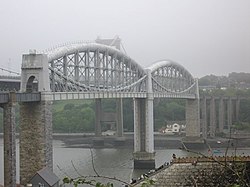Cornwall Railway
| Cornwall Railway | |
|---|---|

The Royal Albert Bridge
that carries the route of the Cornwall Railway across the River Tamar |
|
| History | |
| 1835 | Proposal for a railway from London to Falmouth |
| 1839 | Proposal for the Cornwall Railway |
| 1846 | Cornwall Railway Act |
| 1848–52 | Construction suspended |
| 1859 | Opened from Plymouth to Truro |
| 1863 | Opened Truro to Falmouth |
| 1867 | Branch opened to Keyham Dockyard |
| 1876 | Cornwall Loop line opened in Plymouth |
| 1889 | Line sold to the Great Western Railway |
| Engineering | |
| Engineer | Isambard Kingdom Brunel |
| Gauge |
7 ft 1⁄4 in (2,140 mm) converted to 4 ft 8 1⁄2 in (1,435 mm) standard gauge in 1892 |
| Successor organisation | |
| 1889 | Great Western Railway |
| 1948 | British Railways |
| Key locations | |
| Headquarters | Truro, Cornwall |
| Workshops | Lostwithiel |
| Major stations |
St Austell Truro Falmouth |
| Key structures | Royal Albert Bridge and numerous timber trestle viaducts |
| Route mileage | |
| 1859 | 53.50 miles (86.10 km) |
| 1863 | 65.34 miles (105.15 km) |
The Cornwall Railway was a 7 ft 1⁄4 in (2,140 mm) broad gauge railway from Plymouth in Devon to Falmouth in Cornwall, England, built in the second half of the nineteenth century. It was constantly beset with shortage of capital for the construction, and was eventually forced to sell its line to the dominant Great Western Railway.
It was famous for building the majestic Royal Albert Bridge over the River Tamar, and because of the difficult terrain it traversed, it had a large number of viaducts; because of the shortage of money these were built as timber trestle viaducts, proving to be iconic images but a source of heavy maintenance costs, eventually needing to be reconstructed in more durable materials.
Its main line was the key route to many of the holiday destinations of Cornwall, and in the first half of the twentieth century it carried holidaymakers in summer, as well as vegetables, fish and cut flowers from Cornwall to markets in London and elsewhere in England. The section from Truro to Falmouth, originally part of its main line, never fulfilled its potential and soon became a branch line. Nonetheless the entire route (with some minor modifications) remains open, forming part of the Cornish Main Line from Plymouth to Penzance. The Truro to Falmouth branch continues: the passenger service on it is branded the Maritime Line.
The Cornwall Railway was conceived because of fears that Falmouth would lose out, as a port, to Southampton. Falmouth had for many years had nearly all of the packet trade: dispatches from the Colonies and overseas territories arrived by ship and were conveyed to London by road coach. The primitive roads of those days made this a slow business and Southampton was developing in importance. The completion of the London and Southampton Railway in 1840 meant that dispatches could be taken on to London swiftly by train.
At first the promoters wanted the most direct route to London, even if that meant building a line all the way there, by-passing important towns in Cornwall and Devon. Before the interested parties could raise the money and get parliamentary authority for their line, the Government actually removed the bulk of the packet trade to Southampton, so that most of the income for any new line was removed. Some interests continued to press for the best line to London, hoping that the packet trade would return; if necessary they would link with another new railway, but the huge cost of this proved impossible to raise. A more practical scheme running to Plymouth gradually took priority, and at first the trains were to cross the Hamoaze, the body of water at the mouth of the River Tamar on a steam ferry. This was shown to be unrealistic, and Isambard Kingdom Brunel was called in to resolve the difficulty. He designed the bridge over the River Tamar at Saltash, the Royal Albert Bridge: when it was built it was the most prodigious engineering feat in the world. He also improved the details of the route elsewhere. By reaching Plymouth, the company could connect with the South Devon Railway and on to London over the Bristol and Exeter railway and the Great Western Railway. The line was built on the broad gauge.
...
Wikipedia
